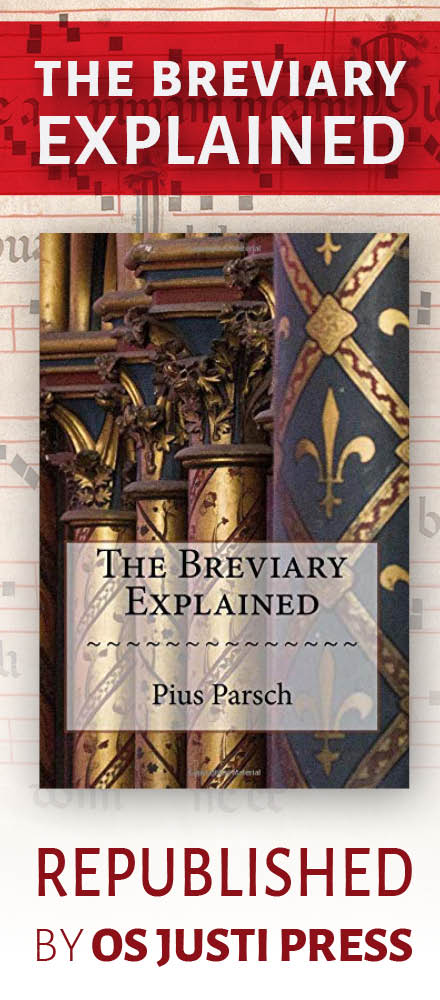Friends at my alma mater, Notre Dame, inform me that the weekly Tridentine Low Mass instituted in the wake of Summorum Pontificium has been moved to the more convenient time of 9:00 AM; furthermore, this Sunday, September 14, the mass will be a sung mass, the first at Notre Dame in nearly four decades. This is a historic occasion, and if you're a student at Notre Dame, a local, or an alum within driving distance, it's worth your time to come out and show your support. It will be held, as usual, at the beautiful chapel of Alumni Hall dorm, in the heart of campus.
The first Low Mass last year absolutely packed the chapel, and even got written up in the alumni magazine. Campus Ministry has been very helpful and accomodating to requests for the Extraordinary Form on campus (as well as featuring it prominently on their website), and will be even more responsive if events like this draw a crowd. So, show up! Notre Dame has been a barometer of the growing resurgence of orthodoxy among the young, and as with events like the Eucharistic Processions of the past four or so years, people across the country will notice and follow its lead.
Sung Mass for the Feast of the Exaltation of the Holy Cross
Sunday, September 14, 2008, 9:00 AM
Alumni Hall Chapel (St. Charles Borromeo), University of Notre Dame, Notre Dame, Indiana (map).
NB: Please let us not turn the comments here into a referendum on Notre Dame. It is sufficient to say that things have greatly changed for the better on campus since the '80s and '90s without getting into particular faculty and programs. It's all been said before, pro and con.
Tuesday, September 09, 2008
Further Tridentine Tidings from the University of Notre Dame
MatthewMore recent articles:
The Annunciation 2025: Dante and the Virgin MaryGregory DiPippo
The specific date of birth of the great poet Dante Alighieri (1265-1321) is unknown, but this Thursday, March 27th, is the anniversary of his baptism, which took place during the Easter vigil of 1266. The language which we call “Italian” today originated as the dialect of his native region of Tuscany (more specifically, of the city of Florence, but...
The Messenger AngelMichael P. Foley
Anonymous, the Archangel Gabriel, depicted on the predella of the high altar at the subsidiary church of Pesenbach, Upper Austria, 1495In the traditional Roman calendar, the feast days of saints are sometimes clustered together to form archipelagos of holiness that allow the faithful to meditate longer on a sacred mystery. These archipelagos do not...
The Third Sunday of Lent 2025Gregory DiPippo
At that time: Jesus was casting out a devil, and the same was dumb: and when he had cast out the devil, the dumb spoke: and the multitudes were in admiration at it: But some of them said: He casteth out devils by Beelzebub, the prince of devils. And others tempting, asked of him a sign from heaven. But he seeing their thoughts, said to them: Every ...
Pictures of Montecassino AbbeyGregory DiPippo
Following up on yesterday’s post of pictures of the crypt of Montecassino Abbey, here are some of the main church and some of the things around it, starting with the most important part of it, the burial site of St Benedict and his sister St Scholastica, behind the high altar.As I am sure our readers know, Montecassino Abbey was heavily bombed duri...
The Prodigal Son in the Liturgy of LentGregory DiPippo
In his commentary on the Gospel of St Matthew, St Jerome writes as follows about the parable of the two sons who are ordered by their father to go and work in the vineyard (21, 28-32). “These are the two sons who are described in Luke’s parable, the frugal (or ‘virtuous’) and the immoderate (or ‘wanton’).” He then connects these two sons with the f...
Another Chant for the Byzantine Liturgy of the PresanctifiedGregory DiPippo
Now the powers of heaven invisibly worship with us, for behold, the King of Glory entereth! Behold, the mystical sacrifice, being perfected, is carried forth in triumph. With faith and love, let us come forth, that we may become partakers of eternal life, Alleluia, Alleluia, Alleluia! (Recording by the Lviv Archeparchial Clergy Choir.) Нині сили ...
The Crypt of Montecassino AbbeyGregory DiPippo
For the feast of St Benedict, here are some pictures of the crypt of the abbey of Montecassino, the site where he ended his days. The crypt was built in the early 16th century, and originally decorated with frescoes, but by the end of the 19th century, these had deteriorated so badly from the humidity that they were deemed unsalvageable. The decisi...
An Interview with Fr Uwe Michael Lang on LiturgyGregory DiPippo
I am sure that our readers will enjoy this interview with the liturgical scholar Fr Uwe Michael Lang of the London Oratory, which was recently published on the YouTube channel of the Totus Tuus Apostolate. It covers a wide range of subjects: Pope Benedict’s teaching on the liturgy, the liturgical abuses in the post-Conciliar period and our own time...
Dives and Lazarus in the Liturgy of LentGregory DiPippo
Before the early eighth century, the church of Rome kept the Thursdays of Lent (with the obvious exception of Holy Thursday) and the Saturdays after Ash Wednesday and Passion Sunday as “aliturgical” days. (The term aliturgical refers, of course, only to the Eucharistic liturgy, not to the Divine Office.) This is attested in the oldest liturgical bo...
The Feast of St Joseph 2025Gregory DiPippo
Truly it is worthy and just... eternal God: Who didst exalt Thy most blessed Confessor Joseph with such great merits of his virtues, that by the wondrous gift of Thy grace, he merited to be made the Spouse of the most holy Virgin Mary, and be thought the father of Thy only-begotten Son, Jesus Christ, our Lord. Wherefore, venerating the day of his b...





















